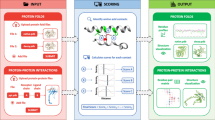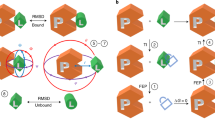Abstract
We have developed PLASS (Protein-Ligand Affinity Statistical Score), a pair-wise potential of mean-force for rapid estimation of the binding affinity of a ligand molecule to a protein active site. This scoring function is derived from the frequency of occurrence of atom-type pairs in crystallographic complexes taken from the Protein Data Bank (PDB). Statistical distributions are converted into distance-dependent contributions to the Gibbs free interaction energy for 10 atomic types using the Boltzmann hypothesis, with only one adjustable parameter. For a representative set of 72 protein-ligand structures, PLASS scores correlate well with the experimentally measured dissociation constants: a correlation coefficient R of 0.82 and RMS error of 2.0 kcal/mol. Such high accuracy results from our novel treatment of the volume correction term, which takes into account the inhomogeneous properties of the protein-ligand complexes. PLASS is able to rank reliably the affinity of complexes which have as much diversity as in the PDB.
Similar content being viewed by others
References
Murcko, A. and Murcko, M.A., J. Med. Chem., 38 (1995) 4953.
Sippl, M.J., Ortner, M., Jaritz, M., Lckner, P. and Flockner, H., Folding Design, 1 (1996) 289.
Mitchell, J.B.O., Laskowski, R.A., Alex, A. and Thornton, J.M., J. Comput. Chem., 20 (1999) 1165.
Mitchell, J.B.O., Laskowski, R.A., Alex, A., Forster, M.J. and Thornton, J.M., J. Comput. Chem., 20 (1999) 1177.
Muegge, I. and Martin, Y.C., J. Med. Chem., 42 (1999) 791.
Ishchenko, A.V. and Shakhnovich, E.I., J. Med. Chem., 45 (2002) 2770.
Gohlke, H., Hendlich, M. and Klebe, G., J. Mol. Biol., 295 (2000) 337.
Muegge, I., Martin, Y.C., Hajduk P.J. and Fesik, S.W., J. Med. Chem., 42 (1999) 2498.
Het Group Dictionary. Available from Brookhaven National Laboratory WWW address ftp://ftp.ebi.ac.uk/pub/databases/ pdb/pub/resources/hetgroups/het_dictionary.txt
Wang, R., Liu, L., Lai, L. and Tang, Y., J. Mol. Model., 4 (1998) 379.
Author information
Authors and Affiliations
Rights and permissions
About this article
Cite this article
Ozrin, V., Subbotin, M. & Nikitin, S. PLASS: Protein-ligand affinity statistical score – a knowledge-based force-field model of interaction derived from the PDB. J Comput Aided Mol Des 18, 261–270 (2004). https://doi.org/10.1023/B:JCAM.0000046819.20241.16
Issue Date:
DOI: https://doi.org/10.1023/B:JCAM.0000046819.20241.16




